TV4001 - Epidemiology 7 - Seroepidemiology
1/43
There's no tags or description
Looks like no tags are added yet.
Name | Mastery | Learn | Test | Matching | Spaced |
|---|
No study sessions yet.
44 Terms
What is serological epidemiology?
One of the main constituents of serum that is frequently measured, is?
Investigation of disease and infection in populations, by the measurement of variables present in serum.
specific antibody activity of globulins

Methods of expressing amounts of antibody
The concentration of antibody is expressed as? What is that?
A titre - the highest dilution of serum that produces a test reaction
Animals with detectable antibody titres are?
nimals with no detectable antibodies are?
What is the third thing?
SEROPOSITIVE
SERONEGATIVE
Animals previously seronegative, and now seropositive, have SEROCONVERTED
Serology can be successfully used as an epidemiological tool in many ways
INTERPRETATION OF SEROLOGICAL TEST RESULTS
It is, generally, impossible to identify?
Why?
Probable origin or cause of a titre in a single test for antibody
Does not, ordinarily, differentiate between ACTIVE and PASSIVE IMMUNE RESPONSE or RECENT or PAST EXPOSURE
Methods of expressing amounts of antibody
If the highest dilution that produces a test reaction is 1 in 32, then the titre is?
How can we use the reciprocal in this example?
1/32
The reciprocal, 32, can be quoted, indicating that the undiluted serum contains 32
times the antibody for reaction
A true positive result derives from?
False positive results occur for a variety of reasons, example includes?
Actual infection
Cross-reaction can occur between an infectious agent and antibodies to different organisms with similar antigens,
A true negative result indicates?
False negative results can occur for several reasons, those being?
Absence of infection
Some animals have induced/natural antigen tolerance = don’t produce ABs when exposed to agent
Poor timing of test fails to detect infection - ABs aren’t made in that time
Unsuitable tests for detecting infection
DETECTING DISEASE WITH SCREENING TESTS
Screening is the application of a test to?
Apparently healthy animals in order to detect infection or sub-clinical disease
It is not diagnostic and requires apt follow up
Can be done on a large scale
Oft used in conjunction with more specific and expenny DX tests
DETECTING DISEASE WITH SCREENING TESTS
What is the “Gold Standard”?
The diagnostic test evaluates? How?
Describe the test results
A definitive DX done by biopsy, surgery, long-term followup or another acknowledged standard of diagnosis
Two categories of animals.
Firstly, animals found to have the disease of interest when tested by an accepted "Gold Standard" of diagnosis, such as biopsy or microbiological culture.
Secondly, disease-free animals tested by the same "Gold Standard"
There are four possible interpretations of test results. Two of which are correct and two of which are wrong
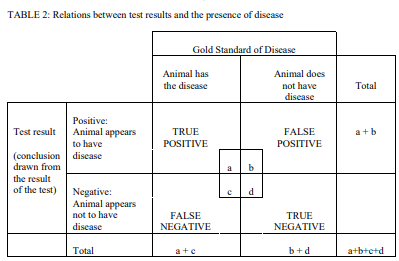
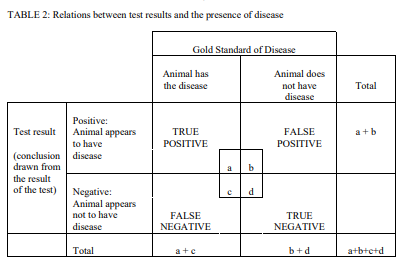
DETECTING DISEASE WITH SCREENING TESTS - Sensitivity and Specificity
The Gold Standard has ID’d which animals having the disease?
The sensitivity of a test is its ability to? How is this expressed?
Has identified (a + c) animals as having the disease of interest, and the "a" animals as having POSITIVE diagnostic results.
Detect diseased animals or its ability to detect the disease when it is present.
This is expressed as a/(a + c) (often as a %)
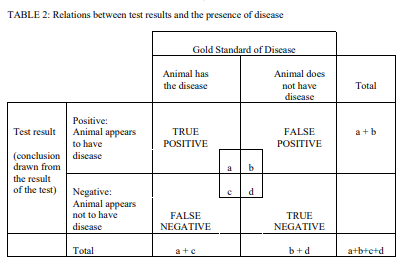
DETECTING DISEASE WITH SCREENING TESTS - Sensitivity and Specificity
Similarly, as shown in the vertical column of the contingency Table 3, the absence of disease is expressed as?
What does this represent?
d/(b+d).
The specificity of a test, which is the ability of a test to detect nondiseased animals or the ability of a test to identify the absence of disease correctl
DETECTING DISEASE WITH SCREENING TESTS - Sensitivity and Specificity
A sensitive test should rarely?
A specific test will rarely?
miss an animal with the disease.
misclassify animals without the disease as diseased
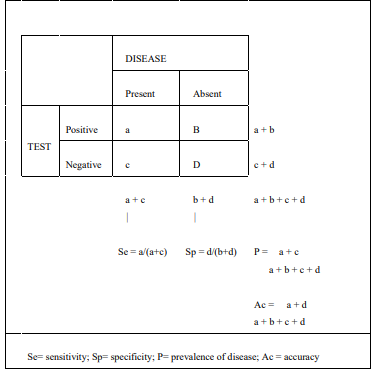
DETECTING DISEASE WITH SCREENING TESTS - Uses of sensitive tests?
Helpful during early stages of DX workup to RULE OUT diseases that are unlikely possibilities
Sensitive tests that are positive usually in disease presence should be used if there is penance for missing a disease
Also useful when the probability of disease is somewhat low and the purpose of this test is to discover disease
DETECTING DISEASE WITH SCREENING TESTS - Uses of specific tests?
Specific tests are useful to "RULE IN" or confirm a diagnosis suggested by other data, a highly specific test is rarely POSITIVE in the absence of disease
Test is apt if a FALSE POSITIVE can harm the animal i.e. test and slaughter policy or cause financial distress or prevalence of disease in pop. is low
PREDICTIVE VALUE OF SCREENING TEST RESULTS
The predictive value of a POSITIVE test is defined as?
How to calculate?
Proportion of true diseased animals among those that test POSITIVE - the probability the animal has the disease when test is +ve
Calculated as a/(a+b)
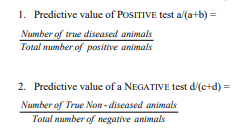
PREDICTIVE VALUE OF SCREENING TEST RESULTS
The predictive value of a NEGATIVE test is?
How to calculate?
The proportion of true non-diseased animals among those that test NEGATIVE - the chance the animal doesn’t have the disease when the test is negative
It is calculated as d/(c+d)
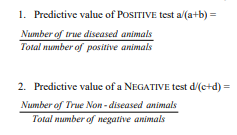
Went up to 15
Methods of improving predictive value
How can we do this?
Screen only high prevalence pop. i.e. pop. with likely high rate of infection
Studies find subgroups with high risk of infection in these groups
Screening can then be concentrated on those with high risk
2nd method - Use more than one screening test
Can be done several ways
Use an inexpensive, relatively sensitive on all animals THEN use a more sensitive expenny test on the animals +ve to first test
Ciuld also use 2+ tests simultaneously to all individuals
Methods of improving predictive value
2nd method - Use more than one screening test
Using 2+ tests simultaneously to all individuals
When tests are used in this manner, the resultant sensitivity and specificity are dependent on the way the results are interpreted, in what ways can we do this?
Parallel interpretation - Animal D+ if it reacts +Ve to one or both tests
Inc sensitivity but dec specificity of combined tests
Series interpretation - Animal D+ if BOTH tests are +ve
Inc specificity but dec sensitivity
MOLECULAR EPIDEMIOLOGY
Molecular epidemiology of infectious disease looks at?
The practical goals of molecular epidemiology are to?
Distribution and determinants of infectious diseases by utilizing molecular biology methods
ID agents responsible for infectious diseases
Determine their physical sources, bio relationships, transmission route
ID genes causing virulence
Find vaccine relevant Ags and Drug resistance
Applications of molecular strain-typing methods to epidemiologic problems
Includes? Describe each
Determining dynamics of disease transmission in geographically widespread areas:
Study intro and spread of agent into area,
ID changes in prevalence of drug-resistance,
find factors that aid transmission
Identifying risk and quantify attributable risk fractions in sporadic outbreaks of infectious diseases
Distinguish epidemic from endemic occurrences of Dz
ID new clones of infectious agents
ID specific vehicles and RF for sporadic infections
Stratifying data and refining epidemiologic study designs
Distinguishing parhovars from nonparhovars
ID new virulence factors and pathos
Addressing hospital and institutional infectious disease problems
Studying nosocomial drug resistant pathos
Distinguish btw nosocomia outbreaks from non-outbreak infection clusters
ID RF for opportunistic infection
Study polyclonal infections
Identifying genetic determinants of disease transmission
ID reasons for enhanced spread of strain in a region
ID gene diffs btw commensal and pathos
ID reasons for emergence of new infectious agents
When to use molecular strain-typing methods
The decision to use a molecular technique as opposed to a particular conventional method should be based on the following considerations…
(i) simplicity, (ii) high throughput, (iii) cost, and (iv) appropriatenessIssues affecting the Sensitivity and Specificity of molecular tests
Issues affecting the Sensitivity and Specificity of molecular tests
Field perspective aspects include?
Collection techniques - Collect only tissue of interest and avoid contaminants amplifying the incorrect product (affects specificity)
Collection of correct tissue
Some agents only found in specific tissues, PCR not specific if wrong one took
Agent may not be uniformly distributed within single tissue type (need subsampling to inc specificity)
Storage / degradation of materials
degradation of nucleic acids is expected and can dec spec and sens
Bacterial loads
May be too low to be picked up by PCR - affects sensitivity
Evolution
Primers good for genes of interest but genes may have mutated - affects specificity
Issues affecting the Sensitivity and Specificity of molecular tests
Lab perspective aspects include
Isolation?
Lysis?
RNA?
Size?
Contamination?
Quantity?
Primer design?
Ratio?
Concentration?
Isolate correct tissue - improper purification can lower the sensitivity test reactions
Shit lysis of cells - no DNA in solution can be amplified = loss of sens
Loss of DNA during purification - DNA not picked up = poor sens
RNA degradation - dec PCR specs&sens
Size of Template - PCR more specific for smaller base pair fragments
Contamination
Buffers, primers, plastic, can skew results
Incorrect DNA by user error/poor purification
DNA quantity
Sample too small or too small quantities
OR product is amplified but detection limit too low to be visible to human eye on gel
Primer design
Poorly designed? = Won’t attach or attach to non-specific products
Primer:Template ratio
Too much primer = reaction prone to gen non-specific products
Too little primer = poor sens
MgCl2 concentration
Mg2+ determines how well primers bind to template
Mg also needed for polymerase and dNTP to work
Higher Mg2+ = less spec binding
Lower Mg2+ = nothing binds
Issues affecting the Sensitivity and Specificity of molecular tests
Lab perspective aspects include
Separation?
Cycles?
Inhibitors?
Mutations?
Conditions?
Temp?
Issues with sensitivity related to template separation
Inhibitos affect sens&specs
PCR inhibitors inc: EDTA, Phenol, Proteinase K
Methods
Polymerase binding
DNA interaction
Interact with polymerase during extension
Cycles
PCR continued beyond exponential amplification phase = non-specific product amplification OR desired product disappears
Polymerase-induced mutations
Taq can’t proofread = shit specs
Reaction conditions
Changed conditions = primers can’t anneal
Changes inc: add glycerol, Dec pH, dec primers/dNTPs/MgC12
Temp
Annealing temp KEY for specificity
Higher temperature, and shorter annealing and extension periods = Higher specs